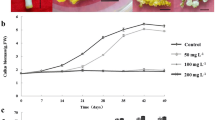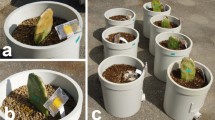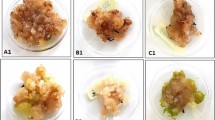Abstract
Chilling ofArabidopsis thaliana (L.) Heynh. callus tissue to 4 °C led to conditions of oxidative stress, as indicated by increased levels of the products of peroxidative damage to cell membranes. Cellular H2O2 was also observed to increase initially upon chilling but by day 8 cellular levels had declined to below control levels. Although levels of catalase activity remained similar to those in unchilled tissue, activity of ascorbate peroxidase increased between days 4 and 8 of chilling to 4 °C. In callus held at 23 °C, levels of reduced glutathione remained static whereas they rose in callus held at 4 °C. Levels of oxidised glutathione were initially low but increased significantly by day 4 in the chilled callus. At 23 °C, however, levels of oxidised glutathione remained low. Between days 1 and 3 at 4 °C, levels of glutathione reductase activity increased but by day 8 glutathione reductase activity was similar to that in cells held at 23 °C. Exposure of callus to abscisic acid at 23 °C also led to increased activities of ascorbate peroxidase and glutathione reductase.
Similar content being viewed by others
Abbreviations
- ABA:
-
abscisic acid
- GSH:
-
reduced glutathione
- GSSG:
-
oxidised glutathione
- TTC:
-
2′,3′5′-triphenyltetrazolium chloride
References
Aono M, Kubo A, Saji H, Natori T, Tanaka K, Kondo N (1991) Resistance to active oxygen toxicity of transgenicNicotiana tabacum that expresses the gene for glutathione reductase fromEscherichia coli. Plant Cell Physiol 32: 691–697
Asada K, Takahashi M (1987) Production and scavenging of active oxygen in photosynthesis. In: Kyle DJ, Osmond CR, Arntzen CJ (eds) Photoinhibition. Elsevier Science Publishers, Amsterdam, New York, Oxford, pp 227–286
Beeor-Tzahov T, Ben-Hayyim G, Holland D, Faltin Z, Eshdat Y (1995) A stress associated citrus protein is a distinct plant phospholipid hydroperoxide glutathione peroxidase. FEBS Letts 336: 151–155
Boveris A, Chance B (1973) The cellular production of hydrogen peroxide. Biochem J 128: 617–630
Burdon RH, Gill V, Boyd PA, O'Kane D (1994) Chilling, oxidative stress and antioxidant enzyme responses inArabidopsis thaliana. Proc R Soc Edinburgh 102B: 177–185
Chen THH, Gusta LV (1983) Abscisic acid-induced freezing resistance in cultured plant cells. Plant Physiol 73: 71–75
Clairborne A (1985) Catalase activity. In: Greenwald EA (ed) CRC. Handbook of methods for oxygen radical research. CRC Press, Boca Raton, pp 283–284
Creissen GP, Broadbent P, Kular B, Reynolds H, Wellburn AR, Mullineaux PM (1994) Manipulation of glutathione reductase in transgenic plants: implications for plant responses to environmental stress. Proc R Soc Edinburgh 102B: 167–175
del Rio LA, Sandalio LM, Palma JM, Bueno P, Corpas FJ (1992) Metabolism of oxygen radicals in peroxisomes and cellular implications. Free Rad Biol Med 13: 557–580
Edwards EA, Ehard C, Creissen GP, Mullineaux PM (1994) Synthesis and properties of glutathione reductase in stressed peas. Planta 192: 137–143
Gamborg OL (1970) The effect of amino acids and ammonia on the growth of plant cells in suspension culture. Plant Physiol 45: 372–377
Gilmour SJ, Hajela RK, Thomashow MF (1988) Cold acclimation inArabidopsis thaliana. Plant Physiol 87: 745–750
Griffith OW (1980) Determination of glutathione and glutathione disulphide using glutathione reductase and 2-vinylpyridine. Anal Biochem 106: 207–212
Guy GL, Carter JV (1984) Characterisation of partially purified glutathione reductase from cold-hardened and non-hardened spinach leaf tissue. Cryobiol 21: 454–464
Jahnke LS, Hull MR, Long SP (1991) Chilling stress and oxygen metabolising enzymes inZea mays andZea diploperennis. Plant Cell Environ 14: 97–104
Jarillo JA, Leyva A, Salinas J, Martinez-Zapater JM (1993) Low temperature induces the accumulation of alcohol dehydrogenase mRNA inArabidopsis thaliana a chilling-tolerant plant. Plant Physiol 101: 833–837
Kubo A, Sano T, Saji H, Tanaka K, Kondo N, Tanaka K (1993) Primary structure and properties of glutathione reductase fromArabidopsis thaliana. Plant Cell Physiol 34: 1259–1266
Levitt J (1980) Responses of plants to environment stress: chilling, freezing and high temperature stress (2nd edn). Academic Press, New York
Loschen G, Azzi A, Flohe L (1973) Mitochondrial H2O2 formation at site II. Hoppe-Seyler Zeit Physiol Chem 354: 791–794
Murashige T, Skoog F (1962) A revised medium for rapid growth and bioassays with tobacco cultures. Physiol Plant 15: 473–497
May MJ, Leaver CJ (1993) Oxidative stimulation of glutathione synthesis inArabidopsis thaliana suspension cultures. Plant Physiol 103: 621–627
Miguel M, James D, Dooner H, Browse J (1993)Arabidopsis requires polyunsaturated lipids for low-temperature survival. Proc Natl Acad Sci USA 90: 6208–6212
Melhorn H (1990) Ethylene-promoted ascorbate peroxidase activity protects plants against hydrogen peroxide, ozone and paraquat. Plant Cell Environ 13: 971–976
Nakano Y, Asada K (1981) Hydrogen peroxide is scavenged by ascorbate peroxidase in spinach chloroplasts. Plant Cell Physiol 22: 867–880
Nohl H, Heger D (1978) Do mitochondria produce oxygen radicals in vivo. Eur J Biochem 82: 563–567
Okuda T, Masuda Y, Yamanaka A, Sagisaka S (1991) Abrupt increase in the level of hydrogen peroxide in leaves of winter wheat is caused by cold treatment. Plant Physiol 97: 1265–1267
Omran RG (1980) Peroxide levels and activities of catalase, peroxidase and indoleacetic acid oxidase during and after chilling cucumber seedlings. Plant Physiol 65: 407–408
Peng M, Kuo J (1992) Peroxidase-generated hydrogen peroxide as a source of antifungal activity in vitro and on tobacco leaf discs. Phytopathology 82: 696–699
Prasad TK, Anderson MD, Martin BA, Steward CR (1994) Evidence for chilling-induced oxidative stress in maize seedlings and a regulatory role for hydrogen peroxide. Plant Cell 6: 65–74
Quinn PJ (1988) Effects of temperature on cell membranes. Symp Soc Expt Biol 42: 237–258
Sandalio LM, Palma JM, del Rio LA (1987) Localisation of Mnsuperoxide dismutase in peroxisomes fromPisum sativum L. Plant Sci 51: 1–8
Sen Gupta A, Webb RP, Holaday AS, Allen RD (1993) Overexpression of superoxide dismutase protects plants from oxidative stress. Plant Physiol 103: 1067–1074
Taylor AO, Slack CR, McPherson HG (1974) Plants under climatic stress VI chilling and light effect on photosynthetic enzymes of sorghum and maize. Plant Physiol 54: 696–701
Towill LE, Mazur P (1975) Studies on the reduction of 2′,3′,5′triphenyltetrazolium chloride as a viability assay for plant tissue culture. Can J Bot 53: 1097–1102
Author information
Authors and Affiliations
Additional information
This work is supported by a grant from the Biotechnology and Biological Sciences Research Council.
Rights and permissions
About this article
Cite this article
O'Kane, D., Gill, V., Boyd, P. et al. Chilling, oxidative stress and antioxidant responses inArabidopsis thaliana callus. Planta 198, 371–377 (1996). https://doi.org/10.1007/BF00620053
Received:
Accepted:
Issue Date:
DOI: https://doi.org/10.1007/BF00620053




